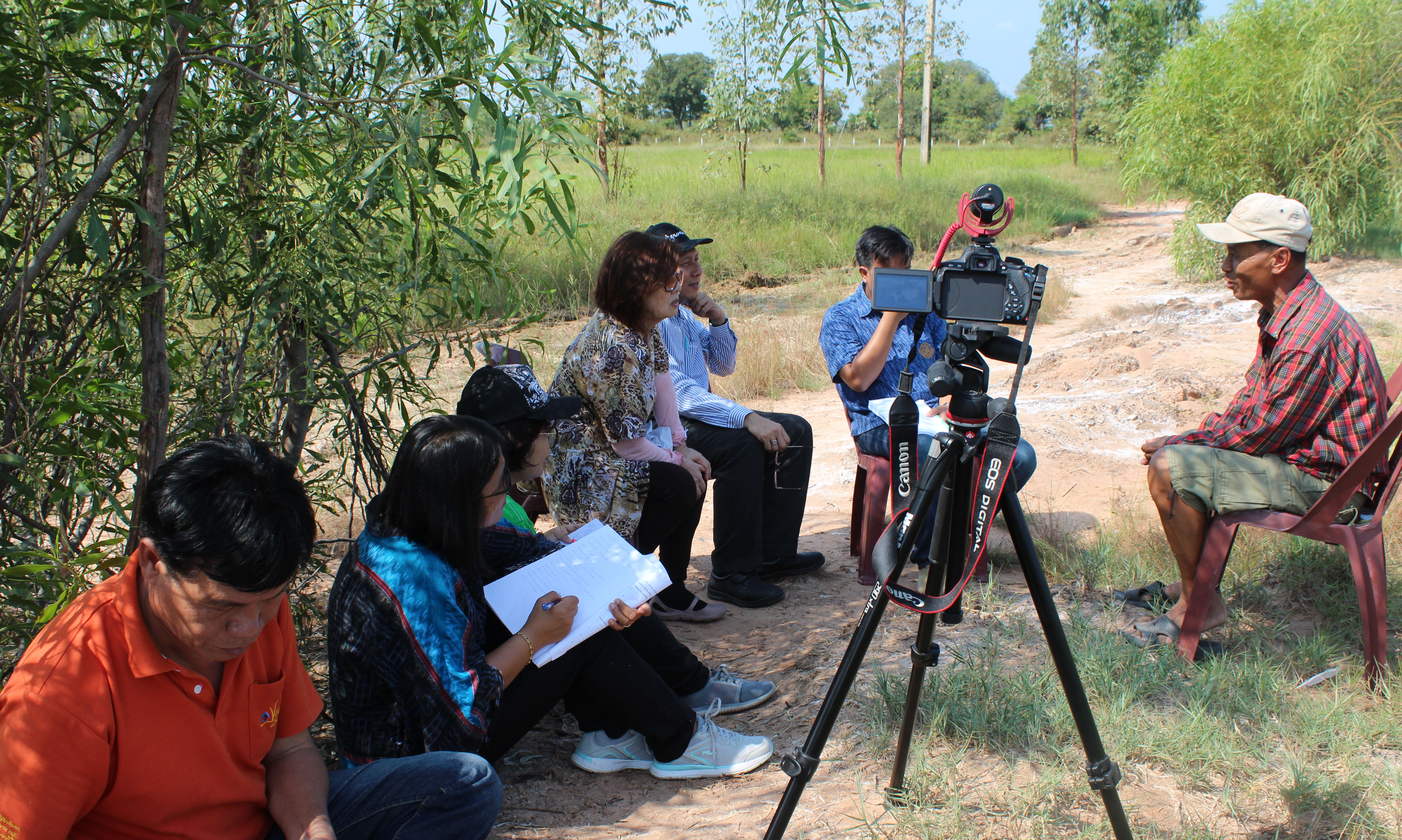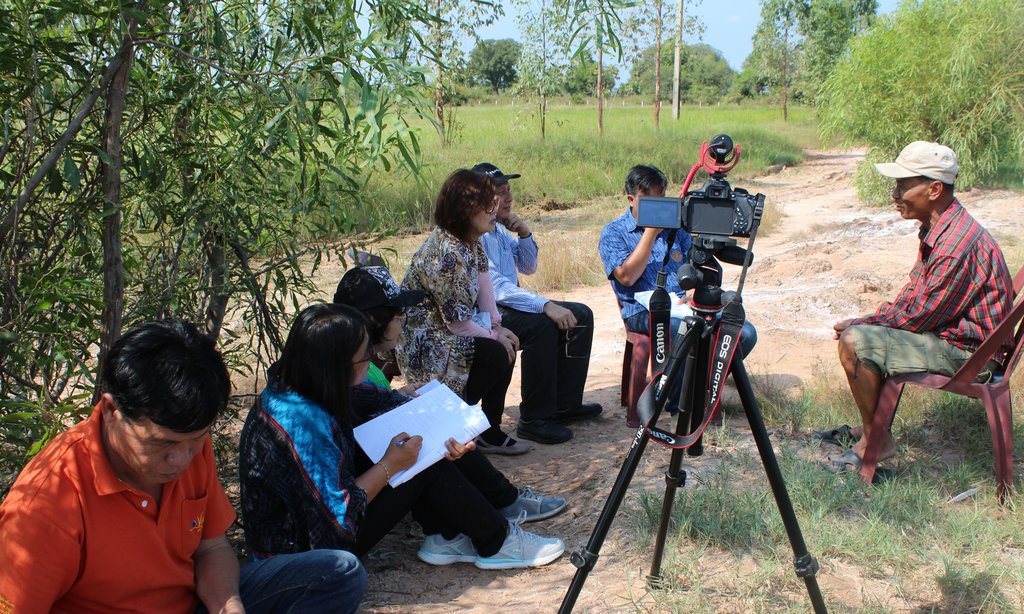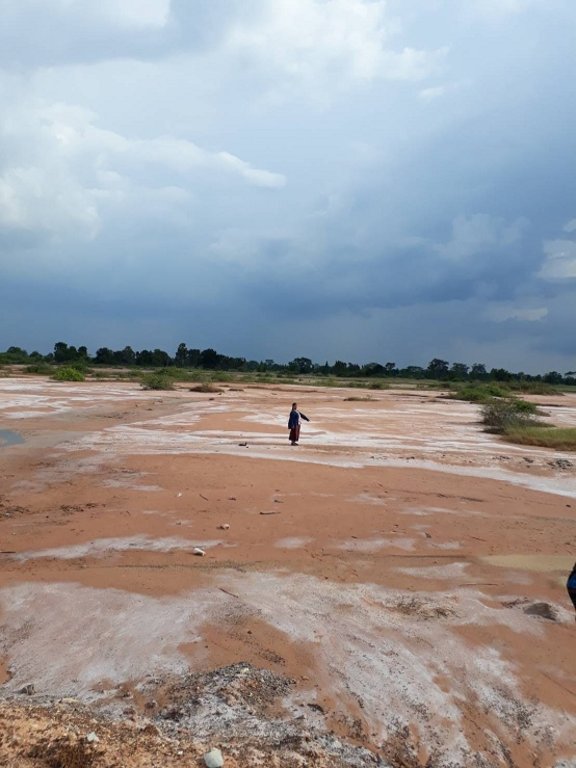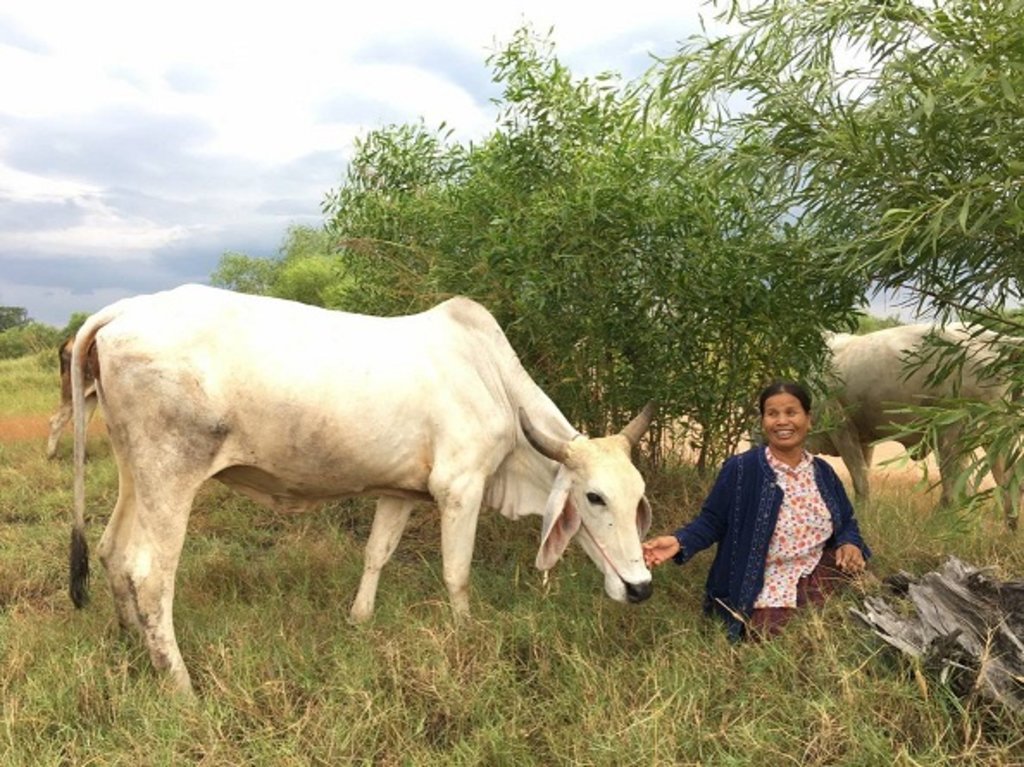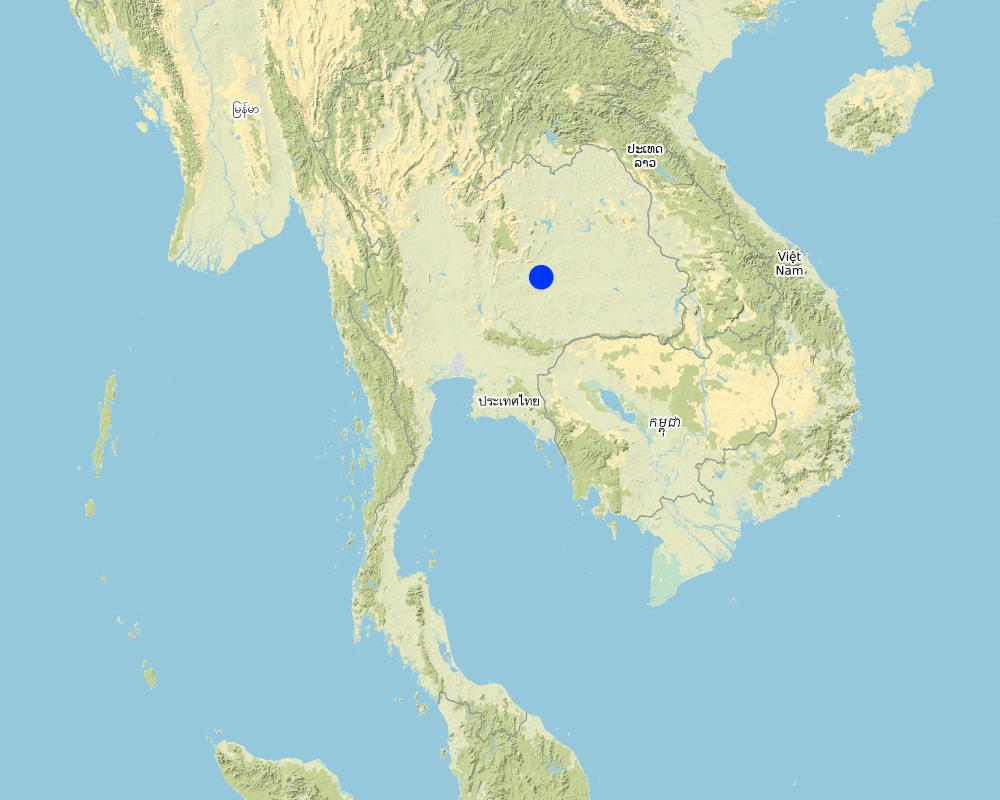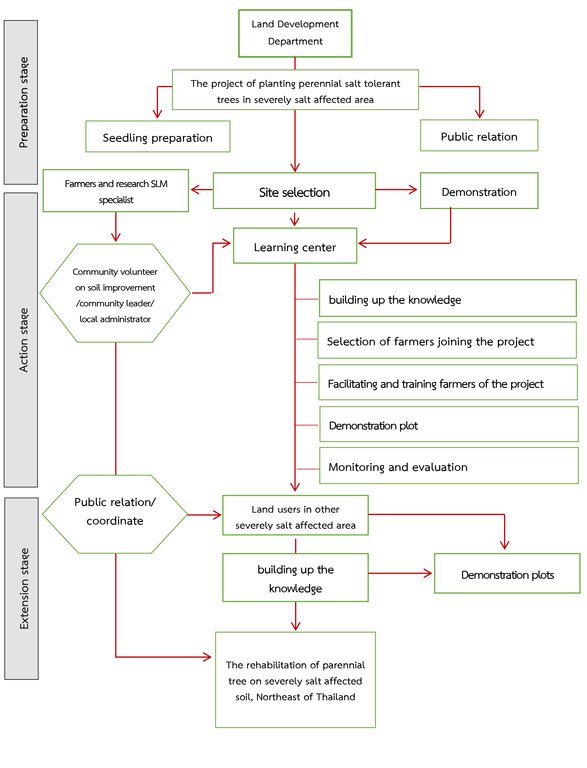Promotion of Acacia ampliceps on severely salt-affected soil [Thailand]
- Creation:
- Update:
- Compiler: Phatranit Chuaysanoi
- Editor: –
- Reviewers: Samran Sombatpanit, Rima Mekdaschi Studer, William Critchley
Planting Acacia ampliceps on severely salt-affected land.
approaches_4203 - Thailand
View sections
Expand all Collapse all1. General information
1.2 Contact details of resource persons and institutions involved in the assessment and documentation of the Approach
land user:
Tathaisong Nurean
+66-62-1521591
-
25 Ban Kok Sa-ard, Moo 10, T. Danchang, A. Buayai, Nakhon Ratchasima, Thailand
Thailand
land user:
Panikom Chartee
+66-85-4395414
-
136/1 Moo 2, T. Danchang, A. Buayai, Nakhon Ratchasima
Thailand
land user:
Salanok Mongkoen
+66-98-1181365
-
184 Moo 2, T. Danchang, A. Buayai, Nakhon Ratchasima
Thailand
land user:
Palinee TubseKaew
+66-87-8706265
-
275 Moo 9, T. Danchang, A. Buayai, Nakhon Ratchasima
Thailand
Soil doctor volunteer:
Ponrat Kumpu
+66-85-6308129
-
106 Moo 9, T. Danchang, A. Buayai, Nakhon Ratchasima
Assistant of village leader:
Pawanna Pakorn
+66-86-2586926
-
34 Moo 9, T. Danchang, A. Buayai, Nakhon Ratchasima
SLM specialist:
Phaosrakhu Chakkaphan
+66-44-371397
yom42@hotmail.com
Technical Group for Land Development, Land Development Regional Office 3, Land Development Department
64 Moo 7, T. Joho, A. Muang, Nakhon Ratchasima 30310
Thailand
SLM specialist:
Oechaiyaphum Kaewjai
+66-83-5429245
issabellalala@gmail.com / KuKaewKaLDD@gmail.com
Chaiyaphum Land Development Station
268/5 Moo 14, T. Na Fai, A. Muang, Chaiyaphum
Thailand
SLM specialist:
Prachansri Saowanee
+66-44-371354
prachansri@gmail.com
Land Development Regional Office 3, Land Development Department
64 Moo 7, T. Joho, A. Muang, Nakhon Ratchasima 30310
Thailand
SLM specialist:
Phiprakon Apisit
+66-44-371397
Technical Group for Land Development, Land Development Regional Office 3, Land Development Department
64 Moo 7, T. Joho, A. Muang, Nakhon Ratchasima 30310
Thailand
SLM specialist:
Prawanna Prasit
+66-44-371397
Technical Group for Land Development, Land Development Regional Office 3, Land Development Department
64 Moo 7, T. Joho, A. Muang, Nakhon Ratchasima 30310
Thailand
National Consultant:
Arunin Somsri
ssarunin@gmail.com
Land Development Department
2003, 61 Phaholyothin Road, Ladyao, Chatuchak, Bangkok 10900
Thailand
SLM specialist:
Name of project which facilitated the documentation/ evaluation of the Approach (if relevant)
Decision Support for Mainstreaming and Scaling out Sustainable Land Management (GEF-FAO / DS-SLM)Name of the institution(s) which facilitated the documentation/ evaluation of the Approach (if relevant)
Land Development Department LDD (Land Development Department LDD) - Thailand1.3 Conditions regarding the use of data documented through WOCAT
When were the data compiled (in the field)?
09/10/2018
The compiler and key resource person(s) accept the conditions regarding the use of data documented through WOCAT:
Ja
2. Description of the SLM Approach
2.1 Short description of the Approach
Planting perennial salt-tolerant trees in the severely salt-affected area in Lam Satad of Chi-Mun watershed was introduced by the Land Development Department at A. Buayai, Nakhon Ratchasima. This project aimed at promoting the planting of Acacia ampliceps on an area of up to 4,665 rai (approx. 745 ha).
2.2 Detailed description of the Approach
Detailed description of the Approach:
Land rehabilitation through Acacia ampliceps planting on severely salt-affected soils has been a subproject of the LDD project on "Planting Perennial Salt-tolerant Trees in Salt-affected Areas in the Northeast of Thailand", which started in 1996. The area of Acacia ampliceps has extended further than 10,000 rai (approx. 1600 hectares) through public relations, demonstration plots, collaboration of community leaders, the local governmental administration, and community volunteers on soil improvement and land users.
The soil salinity map (LDD, 1995) shows that the severely salt-affected land in Northeast Thailand covers 475,200 rai. One of the technologies to address salinity is to decrease the saline shallow groundwater level by planting salt-tolerant trees - which are low input compared with engineering measures. The LDD has been extensively planting Acacia ampliceps through close collaboration and participation of stakeholders and demonstration plots in many severely salt-affected locations of several sub-watersheds, one of the sites being Lam Satad of Chi-Mun watershed. The objectives of the approach are (1) to extend the area of planting Acacia ampliceps to prevent and decrease salination, (2) to maximize the use of salt-affected land for a better environment and crop production, and (3) to extend the knowledge of vegetative measures for salinity control to land users and laymen.
The methods used are through (1) demonstration plots of Acacia ampliceps - planting 2-month-old seedlings in pits as single rows at 80 trees per rai (500 per hectare); (2) the land users got to know the approach through public relations media, local administration, community soil doctor volunteers on soil improvement, community leaders, SLM specialists, and researchers; (3) selection of interested land users under LDD requirements; (4) training of selected land users after joining the project, and (5) monitoring and evaluation after 1 year of planting.
Stakeholders involved are LDD researchers and SLM specialists responsible for establishing planting methods, preparation of land (land leveling and beds for planting), production of seedlings and carrying out demonstration plots, as well as monitoring and evaluation and training at the beginning of planting in new areas. The local administration and community soil doctor volunteers on soil improvement are involved in public relations, recommendations, and strengthening closer participation among farmers. Land users/farmers are to be trained and instructed to follow the technology by SLM specialists. They also participate in the monitoring and evaluation and persuade other land users/farmers to plant Acacia ampliceps.
The land users/farmers favour the technology because they have observed that salinity could be controlled, and they utilize the trees as shade for cattle and the tree branches for producing charcoal. Besides, the land users are self-organized as a group to watch and protect the young trees from being trampled by cattle. The disadvantage of Acacia ampliceps is its sensitivity to flash floods and forest fires. Furthermore, the direct production from the trees is low.
2.3 Photos of the Approach
General remarks regarding photos:
This picture shows a group of Land Development Department officers, land users and stakeholders during knowledge-sharing through meeting and discussion.
2.4 Videos of the Approach
Comments, short description:
Conversation and lesson learned
Date:
09/10/2018
Location:
Ban Nong Mek T. Danchang, A. Buayai, Nakhon Ratchasima
Name of videographer:
Jilayus Sommutram
2.5 Country/ region/ locations where the Approach has been applied
Country:
Thailand
Region/ State/ Province:
Nakhon Ratchasima
Further specification of location:
Ban Kok Sa-ard, Moo 10 T. Danchang, A. Buayai
Comments:
The approach has been applied at Ban Kok Sa-ard M. 10 T. Danchang, A. Buayai, Nakhon Ratchasima
Map
×2.6 Dates of initiation and termination of the Approach
Indicate year of initiation:
2014
If precise year is not known, indicate approximate date when the Approach was initiated:
less than 10 years ago (recently)
Year of termination (if Approach is no longer applied):
2017
Comments:
This approach has been used since 2014 until now.
2.7 Type of Approach
- project/ programme based
2.8 Main aims/ objectives of the Approach
The purpose is to scale-out the approach to persuade farmers on severely salt-affected land in other districts and provinces to grow Acacia ampliceps.
2.9 Conditions enabling or hindering implementation of the Technology/ Technologies applied under the Approach
social/ cultural/ religious norms and values
- enabling
Farmers have mutual respect for the community leader and for each other.
availability/ access to financial resources and services
- enabling
Farmers can access the financial resources through the housing fund.
institutional setting
- enabling
Public relations is done by Sub-district Administration Organization (SAO).
collaboration/ coordination of actors
- enabling
Community leaders, soil doctors (soil improvement volunteers) and successful farmers are working together.
policies
- enabling
Thai government has a policy of rehabilitating salt-affected soils.
knowledge about SLM, access to technical support
- enabling
LDD officers educate farmers in study areas.
3. Participation and roles of stakeholders involved
3.1 Stakeholders involved in the Approach and their roles
- local land users/ local communities
The LDD officers, community leader, soil doctors (soil improvement volunteers) and local administration officers.
Provide knowledge of the technology.
- SLM specialists/ agricultural advisers
SLM specialist, community leader, soil doctors (soil improvement volunteers) and local administration officers.
Technology transfer and implementation
- local government
Local administration / Community leader
Public relations and coordination
If several stakeholders were involved, indicate lead agency:
The LDD officers had extensively worked through close collaboration and participation of community leaders, soil doctors (soil improvement volunteers) and local administration officers.
3.2 Involvement of local land users/ local communities in the different phases of the Approach
| Involvement of local land users/ local communities | Specify who was involved and describe activities | |
|---|---|---|
| initiation/ motivation | passive | Training and demonstration plot was held in the study area. |
| planning | interactive | Public hearing planning was set up before the beginning of the project. |
| implementation | external support | Some farmers were hired labourers in this project. |
| monitoring/ evaluation | interactive | Volunteer soil doctors and community volunteers were in charge of the coordination. |
3.3 Flow chart (if available)
Description:
Flow chart shows three phases of the implementation and approach.
Author:
Mrs. Phatranit Chuaysanoi
3.4 Decision-making on the selection of SLM Technology/ Technologies
Specify who decided on the selection of the Technology/ Technologies to be implemented:
- mainly SLM specialists, following consultation with land users
Explain:
LDD started to do demonstration plots and educate farmers in 2014.
Specify on what basis decisions were made:
- evaluation of well-documented SLM knowledge (evidence-based decision-making)
4. Technical support, capacity building, and knowledge management
4.1 Capacity building/ training
Was training provided to land users/ other stakeholders?
Ja
Specify who was trained:
- land users
If relevant, specify gender, age, status, ethnicity, etc.
Mrs. Nurean Tathaisong, female, 56 years old, married, Thai
Form of training:
- demonstration areas
Subjects covered:
The rehabilitation of severely salt-affected soils by growing Acacia ampliceps could reduce household expenditure and is easy to follow.
Comments:
Mrs. Nurean Thathaisong, female, 56 years old, married, Thai, has been playing an important role as a land user who received training and operated demonstration areas since 2014.
4.2 Advisory service
Do land users have access to an advisory service?
Ja
Specify whether advisory service is provided:
- on land users' fields
Describe/ comments:
1. LDD officers educate farmers in the study area.
2. There is cooperation among community leaders, volunteer soil doctors (soil improvement volunteers) and successful farmers.
4.3 Institution strengthening (organizational development)
Have institutions been established or strengthened through the Approach?
- no
4.4 Monitoring and evaluation
Is monitoring and evaluation part of the Approach?
Ja
Comments:
LDD officers are in charge of monitoring, investigating survival rates and planning for replanting in the next cropping season.
If yes, is this documentation intended to be used for monitoring and evaluation?
Ja
Comments:
There are many issues in a document, which should be used for monitoring and evaluation.
4.5 Research
Was research part of the Approach?
Ja
Specify topics:
- technology
Give further details and indicate who did the research:
LDD researchers
5. Financing and external material support
5.1 Annual budget for the SLM component of the Approach
If precise annual budget is not known, indicate range:
- < 2,000
Comments (e.g. main sources of funding/ major donors):
Land Development Department
5.2 Financial/ material support provided to land users
Did land users receive financial/ material support for implementing the Technology/ Technologies?
Ja
If yes, specify type(s) of support, conditions, and provider(s):
Cost of compost, fertilizer, rice husks, Acacia ampliceps seedlings
5.3 Subsidies for specific inputs (including labour)
- labour
| To which extent | Specify subsidies |
|---|---|
| fully financed | Plantation and maintenance |
- agricultural
| Specify which inputs were subsidised | To which extent | Specify subsidies |
|---|---|---|
| seeds | fully financed | Free seedlings |
| fertilizers | fully financed | Free compost, rice husk and chemical fertilizer with 15-15-15 formula |
- construction
| Specify which inputs were subsidised | To which extent | Specify subsidies |
|---|---|---|
| farm rigged | fully financed | Reshape of farm ridge |
Comments:
There were many subsidies such as labour, agricultural inputs, and construction material, which are free for farmers who have engaged in this project.
5.4 Credit
Was credit provided under the Approach for SLM activities?
Nee
5.5 Other incentives or instruments
Were other incentives or instruments used to promote implementation of SLM Technologies?
Nee
6. Impact analysis and concluding statements
6.1 Impacts of the Approach
Did the Approach empower local land users, improve stakeholder participation?
- No
- Yes, little
- Yes, moderately
- Yes, greatly
To develop food security and reduce farm household
Did the Approach enable evidence-based decision-making?
- No
- Yes, little
- Yes, moderately
- Yes, greatly
Learning center and source of information in the decision-making process on technology adoption
Did the Approach help land users to implement and maintain SLM Technologies?
- No
- Yes, little
- Yes, moderately
- Yes, greatly
Farmers were taking care of technology because it causes of expenditure reduction
Did the Approach mobilize/ improve access to financial resources for SLM implementation?
- No
- Yes, little
- Yes, moderately
- Yes, greatly
It would be a guarantee for loan deposit
Did the Approach improve knowledge and capacities of land users to implement SLM?
- No
- Yes, little
- Yes, moderately
- Yes, greatly
Self-adaptation and changing of SLM patterns
Did the Approach improve knowledge and capacities of other stakeholders?
- No
- Yes, little
- Yes, moderately
- Yes, greatly
Government agencies and the private sector development patterns of SLM
Did the Approach lead to improved access to water and sanitation?
- No
- Yes, little
- Yes, moderately
- Yes, greatly
According to technology adoption, it could result in desalinization and income enhancement
6.2 Main motivation of land users to implement SLM
- increased production
Increase of arable land
- reduced land degradation
Desalinization
- reduced workload
Increase of pasture land
6.3 Sustainability of Approach activities
Can the land users sustain what has been implemented through the Approach (without external support)?
- yes
If yes, describe how:
Most farmers have a good understanding of the rehabilitation of Acacia ampliceps on severely salt-affected soils. Moreover, farmers can get benefit of expenditure reduction through utilization of tree branches as charcoal.
6.4 Strengths/ advantages of the Approach
| Strengths/ advantages/ opportunities in the land user’s view |
|---|
| 1) Acacia ampliceps is a perennial salt-tolerant tree, which can grow well in the severely salt-affected area. |
| 2) Desalinization resulted from Acacia ampliceps plantation after 2 years of planting, native grasses return and become grazing land. |
| 3) Tree branches of Acacia ampliceps could be utilized as charcoal; and the land was changed from barren to trees that become shading. |
| 4) Soil doctors (soil improvement volunteers) were in charge of coordination. |
| Strengths/ advantages/ opportunities in the compiler’s or other key resource person’s view |
|---|
| 1) There were LDD officers working with a community leader, soil doctors (soil improvement volunteers) and SAO (Sub-district Administration Organization) officers, who can suggest and support necessary information to the farmer. |
| 2) Land Development Department operates demonstration plots. |
6.5 Weaknesses/ disadvantages of the Approach and ways of overcoming them
| Weaknesses/ disadvantages/ risks in the land user’s view | How can they be overcome? |
|---|---|
| 1) If a farmer does not engage with this project, he will have no knowledge how to plant Acacia ampliceps in the farm. Moreover, he will not know where to buy Acacia ampliceps seeds. | The LDD has extensively worked through close collaboration and participation of community leader, soil doctors (soil improvement volunteers) and local administration officers on public relations and persuade other land users/ farmers to plant Acacia ampliceps. |
| Weaknesses/ disadvantages/ risks in the compiler’s or other key resource person’s view | How can they be overcome? |
|---|---|
| 1) If a farmer doesn’t engage with this project, they don’t have knowledge how to desalinization by planting Acacia ampliceps. Moreover, they don’t know that severely salt-affected soils become less saline to become rice field after 3 years of planting Acacia ampliceps. | There must have training/ suggesting farmers to know the benefits of Acacia ampliceps planting. |
7. References and links
7.1 Methods/ sources of information
- interviews with land users
Six persons about Acacia ampliceps plantation
- interviews with SLM specialists/ experts
Seven LDD officers
7.2 References to available publications
Title, author, year, ISBN:
Land Development Department
Available from where? Costs?
http://www.ldd.go.th/
7.3 Links to relevant information which is available online
Title/ description:
Where the land is greener - Case Studies and Analysis of Soil and Water Conservation Initiatives Worldwide
URL:
http://www.ldd.go.th/www/lek_web/
Links and modules
Expand all Collapse allLinks
No links
Modules
No modules


